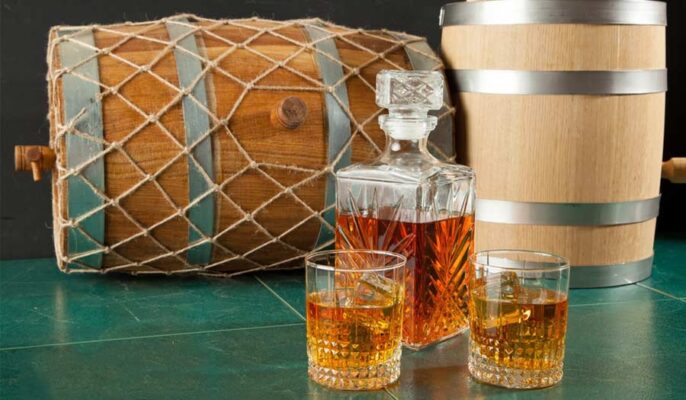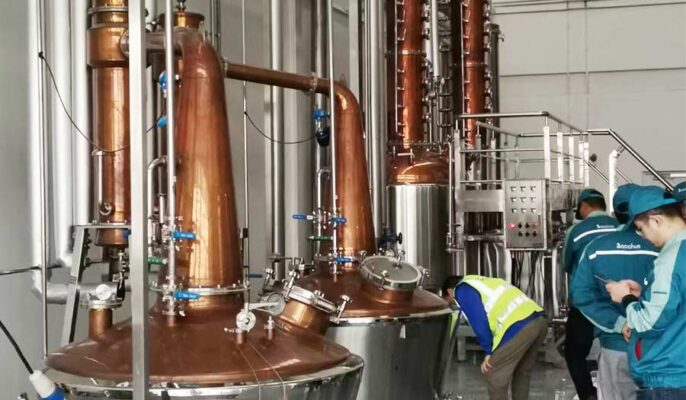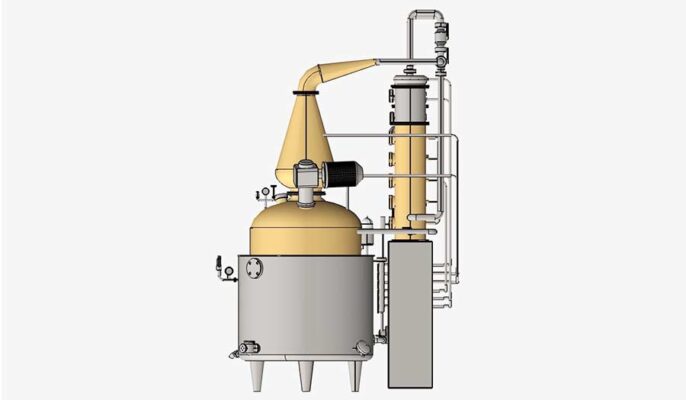Si vous voulez produire un vin délicieux, il est essentiel d'avoir le bon vin. équipement de distillation. Qu'il s'agisse d'un débutant ou d'un maître dans l'industrie vinicole, le fait de disposer du bon équipement de distillation leur permet de maximiser le potentiel de leurs produits. La distillation commence par la fermentation d'un liquide, tel qu'un alcool liquide (moût ou vin), qui est chauffé dans un distillateur. À mesure que le liquide chauffe, l'alcool s'évapore et monte au sommet du distillateur, où il est recueilli et concentré en une solution très concentrée. Cet article présente en détail l'utilisation du matériel de distillation pour la vinification, y compris la sélection du matériel et d'autres informations.
Qu'est-ce que le vin distillé ?
Le vin distillé est un vin qui a été traité pour en augmenter la teneur en alcool. L'alcool contenu dans le vin est produit par la fermentation. Les raisins de cuve sont écrasés pour en extraire le jus, que les viticulteurs appellent moût. Le jus de raisin contient des sucres, qui sont transformés en alcool lorsqu'on y ajoute de la levure.
Lorsque le taux d'alcool est trop élevé, les levures ne peuvent survivre, ce qui limite naturellement la concentration du vin fermenté. C'est pourquoi on ne trouve pas de vin ordinaire avec un taux d'alcool supérieur à 16%. Pour obtenir une boisson plus alcoolisée, il faut distiller le vin.

Principes de base équipement de distillation
La distillation est un processus de séparation des différents composants d'un mélange liquide en fonction des différents points d'ébullition de chaque élément. Le matériel de distillation sépare l'alcool et d'autres composants en chauffant le liquide pour le transformer en vapeur, puis en le condensant en liquide. Les équipements de distillation courants comprennent un distillateur (tel que le distillateur commun en cuivre), un équipement de distillation à tour et un équipement de distillation à reflux.
- Pot de chauffage : utilisé pour chauffer le liquide de fermentation afin de favoriser son évaporation.
- Générateur de vapeur : dirige la vapeur générée par le chauffage vers le dispositif de condensation.
- Condenseur : refroidit la vapeur en liquide, en utilisant de l'eau de refroidissement ou un système de refroidissement par air.
- Récipient de réception : utilisé pour recueillir le liquide distillé.
Processus de distillation et de brassage
- Sélection des matières premières : En fonction du type d'alcool cible, les matières premières appropriées sont sélectionnées, telles que les céréales (orge, maïs, seigle), les fruits (raisins, pommes), les mélasses, etc.
- Fermentation : Mélanger les matières premières avec de l'eau pour obtenir un liquide de fermentation. La levure est ajoutée au liquide de fermentation et transforme les sucres en alcool et en dioxyde de carbone. Les différentes souches de levure ont des effets différents sur le processus de fermentation et la saveur finale.
- Distillation : Verser le liquide fermenté dans un récipient de distillation et le chauffer pour évaporer l'alcool et les autres composants volatils. La vapeur d'alcool évaporée est refroidie par un condenseur et recondensée en un liquide, qui est le liquide distillé.
- Vieillissement : Dans des conditions spécifiques de température et d'humidité, l'alcool liquide réagit chimiquement avec le matériau contenu dans le récipient (comme le chêne) pour produire des saveurs et des arômes complexes.
- Mélange et filtration : Différents lots de liqueur distillée sont mélangés pour assurer la cohérence des saveurs. Les solides résiduels et les impuretés sont éliminés par filtration afin d'améliorer la pureté et le goût de l'alcool.
- Conditionnement : Le produit final est mis en bouteille, étiqueté et scellé, prêt à être vendu. Un contrôle de qualité est effectué avant l'emballage afin de garantir la conformité aux normes.
Types de procédés de distillation
- Distillation fractionnée : Ce procédé consiste à distiller plusieurs fois le même liquide. La distillation est effectuée plusieurs fois à des températures croissantes afin d'éliminer différentes substances du mélange.
- Distillation à la vapeur : La distillation permet d'extraire tous les éléments des composés sensibles à la température. La mise en œuvre de ce processus nécessite de soumettre le liquide à différentes températures d'ébullition.
- Distillation sous vide : Certaines substances présentes dans le liquide ont des points d'ébullition extrêmement élevés. Dans ce cas, il est plus efficace de réduire la pression de la tour. De cette manière, les éléments du mélange dont la pression de vapeur est beaucoup plus faible peuvent s'évaporer plus facilement.
Matériel de distillation nécessaire au processus de brassage
- Tonneau à moût : Ce récipient mélange le malt à l'eau à une température contrôlée, convertissant l'amidon en sucres fermentescibles grâce à l'empâtage, ce qui déclenche le processus de fermentation du moût. Le récipient est équipé d'un faux fond et de tamis pour séparer les drêches du liquide, produisant ainsi un moût prêt à être fermenté.
- Cuve de fermentation: La cuve de fermentation est essentielle à la transformation des sucres en alcool et sert à stocker le moût auquel on ajoute la levure. Le contrôle de la température est essentiel pendant le processus de fermentation, qui peut durer plusieurs jours. La cuve de fermentation est équipée d'une soupape de décompression qui permet d'évacuer en continu les gaz produits lors de la fermentation.
- Pompes : Si les petites brasseries peuvent être gérées manuellement, les grandes brasseries s'appuient sur des pompes pour déplacer les liquides de manière sûre et efficace. Une installation typique peut comprendre une pompe à moût et une pompe à haute concentration pour simplifier l'opération.
- Alambic : les alambics ressemblent à de grandes bouilloires et sont idéaux pour produire des spiritueux au goût prononcé, comme la tequila ou le whisky single malt. Ils nécessitent des temps d'arrêt réguliers pour le nettoyage et le remplissage, et leur efficacité est limitée, mais ils produisent des arômes uniques.
- Alambics à colonne : Ces alambics sont constitués de colonnes et de plateaux verticaux qui permettent une distillation continue et conviennent aux spiritueux plus légers tels que la vodka, le rhum et le gin. Bien qu'ils n'aient pas la saveur des alambics à pot, ils sont plus efficaces.
- Condenseurs : Les serpentins qui refroidissent et condensent l'alcool évaporé, les condenseurs permettent de recueillir l'alcool concentré. Souvent, le produit subit des distillations supplémentaires pour le concentrer davantage.
- Matériel de filtration : Diverses options telles que les filtres à poches, les cartouches filtrantes ou le papier filtre permettent d'éliminer les particules et de clarifier l'alcool avant son stockage, améliorant ainsi sa qualité et son aspect.
- Récipients de stockage et de vieillissement : Les cuves en acier inoxydable et les fûts de chêne sont des choix courants pour le stockage des spiritueux distillés, ce qui leur permet de mûrir et de développer leur saveur avant la mise en bouteille.
- Des équipements propres et sûrs : Le maintien de la propreté et la garantie de la sécurité sont des priorités absolues dans les opérations de distillation. Des équipements sanitaires et des mesures de sécurité adéquats sont essentiels pour préserver la qualité des produits et la santé des travailleurs.

Comment choisir le matériel de distillation ?
Types de matériel de distillation
Il existe de nombreux types d'équipements commerciaux de distillation de l'alcool, chacun ayant une fonction différente dans le processus de distillation. Il en existe trois types principaux : les alambics à pot, les alambics à colonne et les alambics hybrides. Les alambics à repasse sont connus pour leur fabrication traditionnelle et artisanale, idéale pour les petits lots. En revanche, les alambics à colonne conviennent mieux à la production à grande échelle en raison de leur processus de distillation continue. Les alambics hybrides trouvent un équilibre entre les deux, combinant des éléments des alambics à pot et des alambics à colonne pour une plus grande polyvalence.
Capacité et taille
Pour optimiser la production, il est essentiel de déterminer la taille et la capacité adéquates de l'équipement de distillation. Avant de prendre une décision, tenez compte de vos objectifs de production, de la demande prévue et de l'espace disponible. Investir dans un équipement qui répond à vos besoins de production et qui n'est pas surutilisé ou sous-utilisé est essentiel pour la rentabilité.
Qualité des matériaux et construction
La qualité des matériaux utilisés dans les équipements de distillation commerciale a un impact significatif sur leurs performances et leur durée de vie. L'acier inoxydable est un choix courant en raison de sa durabilité, de sa résistance à la corrosion et de sa facilité de nettoyage. Les pièces en cuivre de qualité supérieure peuvent également rehausser la saveur de certains spiritueux, comme le whisky.
Méthodes de chauffage et contrôle de la température
Un chauffage efficace et précis est essentiel pour obtenir le degré d'alcool et le profil aromatique souhaités. Les méthodes de chauffage varient, allant du feu direct à la vapeur ou au chauffage électrique. Chaque méthode a ses avantages et influe sur les caractéristiques de l'alcool final. En outre, des mécanismes complexes de contrôle de la température sont essentiels pour maintenir la cohérence au cours du processus de distillation.
Sécurité et conformité
La distillation de l'alcool implique des processus potentiellement dangereux, c'est pourquoi la sécurité est une priorité absolue. Lors de l'achat d'un équipement de distillation commerciale, il convient de s'assurer qu'il répond aux normes et réglementations en matière de sécurité. Le respect des réglementations locales et internationales est essentiel pour éviter les problèmes juridiques et garantir le bien-être des opérateurs et des consommateurs.

FAQ
Comment préparer les matières premières ?
Sélectionnez les matières premières appropriées (telles que les céréales, les fruits ou la mélasse) et procédez à la transformation nécessaire. Par exemple, broyer les grains et les saccharifier, ou presser les fruits pour en faire du jus. Assurez-vous que les matières premières sont propres et répondent aux exigences de la vinification.
Comment installer le matériel de distillation ?
Verser le liquide fermenté dans l'alambic et le chauffer pour faire évaporer l'alcool. La vapeur est refroidie et transformée en liquide par le condenseur. Réglez la température de chauffage et les conditions de condensation de manière à ce que le processus de distillation se déroule sans heurts.
Comment traiter la mousse pendant le processus de distillation ?
Ajoutez des inhibiteurs de mousse ou utilisez des brise-mousse pour éviter que la mousse ne déborde et n'affecte l'effet de la distillation. Veillez à ce que le niveau de liquide de l'alambic soit approprié pour éviter une production excessive de mousse.
Comment garantir l'efficacité de la distillation ?
Vérifier régulièrement l'état de la tour de fractionnement, du condenseur et des autres composants afin de les maintenir propres et en bon état de fonctionnement. Ajuster le taux de reflux et les paramètres de chauffage de la tour de fractionnement pour optimiser l'effet de séparation.
Comment nettoyer et entretenir le matériel ?
Suivez les directives de nettoyage et d'entretien du fabricant de l'équipement et nettoyez régulièrement l'alambic, le condenseur et les autres composants clés. Vérifier régulièrement le fonctionnement de l'équipement pour s'assurer que toutes les pièces fonctionnent correctement.




